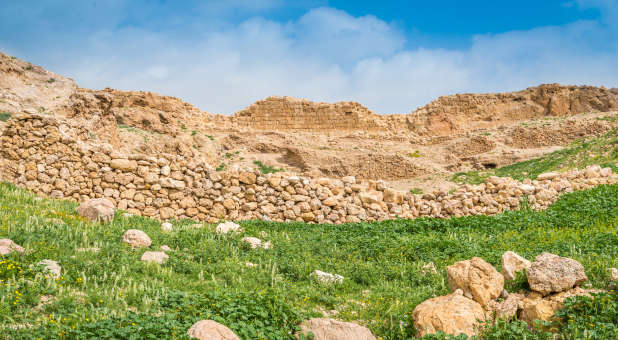Prayer to Jesus Discovered on Ancient Stone in Judean Desert
Archaeologists from the Hebrew University of Jerusalem recently made a remarkable discovery in Israel’s Judean desert. Unearthed at a remote site dating back to the early sixth century, this Byzantine Greek inscription carries immense historical and religious significance.
Situated in an area accessible only by donkeys due to its lack of roads, the inscription adorns a building stone from an ancient monastery. Marked with a cross, it comprises a phrase paraphrasing the first two verses of Psalm 86: “Jesus Christ, guard me, for I am poor and needy.” This remarkable find is unique in its grandeur and serves as a testament to the enduring power of faith.
An inscription dated to the Byzantine era at discovered Hyrcania in the Judean Desert. It adapts Psalm 86:1–2 addressing it to Jesus; saying “Jesus Christ, guard me, for I am poor and needy. Guard my life, for I am faithful to you”. pic.twitter.com/SmHyinxu6O
— Dr. Haim Cohen دكتور حاييم كوهين (@Haim44) October 3, 2023
Epigraphist Avner Ecker of Bar-Ilan University notes the inscription’s “minor grammatical errors,” suggesting that the individual responsible for it likely spoke a Semitic language rather than native Greek. The location of the discovery, about 10.5 miles southeast of Jerusalem and five miles from Qumran and the Dead Sea, holds historical significance as well.
“This psalm holds a special place in the [Hebrew] Masoretic text as a designated prayer and is notably one of the most frequently recited psalms in Christian liturgy,” Ecker says. “Thus, the monk drew a graffito of a cross onto the wall, accompanied by a prayer with which he was very familiar.”
The site, known as Hyrcania, was a fortress dating back to the late second or early first century BC. Around AD 492, a Christian monk named Holy Sabbas established a small monastery there. Even after the Islamic conquest of the Byzantine province Palaestina Secunda in AD 635, the monastery continued to operate, demonstrating the persistence of the Christian faith amidst changing times. However, by the early ninth century, the monastery was apparently abandoned.
Despite attempts to revive the monastery in the 1930s, local Bedouins thwarted those efforts.
The recent archaeological excavation led by Oren Gutfeld and Michal Haber marks the first academic and methodological exploration of the site. Their team, with assistance from Carson-Newman University and American Veterans Archaeological Recovery members, hopes to further decipher the site’s inscriptions using advanced technology.
This remarkable discovery not only sheds light on the rich history of Christianity in the region but also illustrates the importance of preserving and exploring our shared heritage with Israel. {eoa}
Join Charisma Magazine Online to follow everything the Holy Spirit is doing around the world!
James Lasher is Staff Writer for Charisma Media.














































